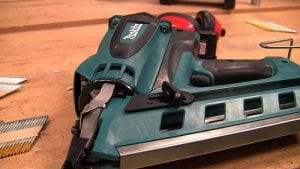Finish Nailer VS Brad Nailer
These two twos look very much alike, they are the same size and they use similar nails. So what is the difference? If you look at these two tools in terms of size, you will notice that a brad nailer is slightly smaller than a finish nailer (click here for the review). Brad nailers do not have the same amount of holding power because they use brads instead of nails. Brads are a thinner gauge nail which is used to attach lightweight trim applications. This gives them a slight advantage over finish nailers when it comes to covering up the holes after you are done.
With brad nails there is less chance of your wood surface splitting because of the thinner gauge nail. A finish nailer is a much more versatile option compared to a brad nailer. It will not perform as well on more delicate wood finishes as a brad nailer so it depends on the type of project you are planning on doing. Finish nailers have a much stronger holding power which is great for if you are attaching heavier pieces of trim such as baseboards and wider crown mouldings.
For these types of applications a finish nailer is your best option. A brad nail will easily detach or pull away from drywall surfaces which is why a finish nailer is the best option. Finish nailers have a larger diameter head which does leave you with more filling to do after you have finished but would you rather have a well disguised hole or a structurally sound trim that is not going to collapse onto your head at some point.
What is a Straight Nailer?
The term “straight or angled” refers to the angle of the magazine. When you think of an angled finish nailer, you immediately think of all the tight nooks and crannies you can get into because of its angled shape. Angled nailers are more expensive but you pay for accuracy since they are always spot on target while straight nailers are more bulky and tend to be cheaper than angled nailers. Angled nails shoot a larger nail while straight nailers fire smaller and thinner ones.
The nose tips of angled nailers are much smaller, which allows for precision work on smaller trim applications. Straight nailers have a T-shaped head while angled nailers have a D-shaped head. The D-shaped nail head is a much better option than the T-shaped heads of a straight nailer. Straight nailers are more bulky and cumbersome than their angled counterparts and are unable to get into tight corners or small spaces.
They lack accuracy and agility which is not the case with angled nailers. If your project does not have any difficult to reach areas then a straight nailer will suffice. However, for light weight trim applications it might be a good idea to consider an angled nailer for a little more finesse.
What is a Framing Nailer?
 When the job calls for nailing large pieces of material together quickly and accurately, a framing nailer is the perfect tool. Framing nailers are intended for quick, high powered projects unlike their smaller counterparts which are mainly used for prescient work. The majority of framing nailers are pneumatic, meaning they are powered by an air compressor. There are a handful of framing nailers which are battery or fuel powered. Coil style framing nailers use a round magazine which is capable of storing more nails than the standard stick-style magazine nailers.
When the job calls for nailing large pieces of material together quickly and accurately, a framing nailer is the perfect tool. Framing nailers are intended for quick, high powered projects unlike their smaller counterparts which are mainly used for prescient work. The majority of framing nailers are pneumatic, meaning they are powered by an air compressor. There are a handful of framing nailers which are battery or fuel powered. Coil style framing nailers use a round magazine which is capable of storing more nails than the standard stick-style magazine nailers.
If you will be using a large amount of nails for a project then the round magazine will allow you to work for extended period before having to reload. Framing nailers use nails measuring 31/2 inches which are used to join 2×4’s. These nailers come in two varieties, clipped head and round head. A clipped nailer can hold more nails but is restricted by certain building codes. Round heads take less nails but are acceptable everywhere.
Nail Gauge Chart
Nail guns are a blessing when it comes to completing construction or renovating work quickly and easily. How does one know which size nails to use? Some of the more commonly used nail sizes are:
4d to 10d
4d to 10d nails are small nails used for finishing. They are not meant to be seen and are used on things like trim. They can be filled over with wood putty or glue with a glue gun which is sanded smooth and painted over.
Related: Wood Glue Review.
12d and 16d
These nails are much stronger than 4d and 10d nails, making tem perfect for use with a framing nailer. Larger wood applications will benefit from these size nails as it is necessary for a stronger hold to keep them together.
Roofing Nails
 These nails are specifically designed for roofing purposes and are used solely for roofing applications.
These nails are specifically designed for roofing purposes and are used solely for roofing applications.
Hot-dipped Nails
Hot-dipped nails are coated in molten zinc. They are designed for outdoor applications because of their ability to stand up to moisture, corrosive che3micals and rain. They have a strong long lasting power.
Electroplated Nails
This type of nail is also coated in zinc but are not as strong as their hot-dipped counterparts
Blued Nails
These nails are weaker than both hot dipped and electroplated nails and are designed solely for inside use.
Cemented Nails
Also known as 16d nails, these work best in framing guns. They are coated in cement to prevent rusting which make them great for outdoor applications.
Aluminium Nails
These are the weakest type of nails and should only be used for modest things like aluminium sheeting.
Copper Nails
Copper nails are stronger than aluminium nails and can be used primarily on boats and other marine projects.
Steel Nails
This is the most commonly used nail as it is less inclined to rust.